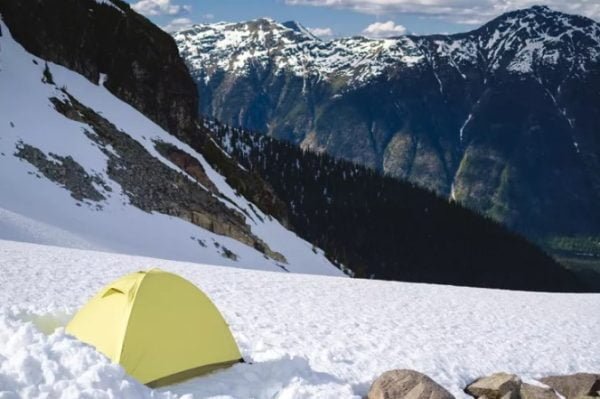Nothing makes or breaks a camping trip more than how comfortable you are at night, and keeping warm is a priority in most seasons. Whether you’re planning a summer camping trip by the beach or a multi-day hike through forests and mountains, your gear plays an important part in staying warm after the sun goes down. And with a few exceptions, temperatures almost always drop at night. Here are some important tips for how to stay warm in a tent, from how you should set up the tent in the first place, the clothing you need, and actions you should take before crawling into your sleeping bag.
Set Your Tent Up Properly
If you don’t pitch a tent often, you might be confused by the number of layers your tent has. On a fine day, it may feel unnecessary to put a camping tarp under your tent, or to put the top fly sheet on. However, these are both important ways of insulating your tent. Fly sheets minimize moisture and help keep rain or morning dew from penetrating the inner layer of your tent, so it’s important to anchor them properly. Most tents don’t come with a tarp to lay beneath the tent but these are inexpensive and a good extra defense against the cold ground. Four-season tents are designed to help keep you warm in those colder conditions but even inexpensive or lighter-weight tents can protect you from many elements when set up properly.

Get a Season-Appropriate Sleeping Bag
Sleeping bags come in many different varieties, and most will note which seasons they’re suitable for. Lightweight sleeping bags are usually only appropriate for summer camping (defined according to a temperature range that isn’t too low overnight). Thicker sleeping bags or those made from better quality and more insulating materials may be more comfortable in lower temperatures. Winter-weight sleeping bags are often very thick or heavy (or just very expensive!) and are usually only appropriate if you’re going camping in temperatures that drop below freezing overnight.
Use an Insulated Sleeping Mat or Pad
You might think you can handle a night or two sleeping just in a sleeping bag, especially if the ground beneath you isn’t too hard or stony, but this is surprisingly uncomfortable and actually very cold. Sleeping mats, especially those that are insulated, provide a warmer layer between you and the ground. When camping in warm summer conditions you may not need an insulated pad to stay warm, but they’re preferable to non-insulated ones at any other time of year.
Wear Different Night Clothes
This is most important if you’re hiking or backpacking and carrying minimal gear. Whatever the season, you’re likely to get sweaty when walking in the daytime. Aside from it feeling unpleasant to sleep in clothes that are dirty and sweaty from the day, it’s also potentially dangerous to go to bed wearing damp clothes. When temperatures drop at night, damp clothes can chill your body even more. Keep a separate set of sleeping clothes when you’re backpacking that you protect from getting wet at all costs.
Don’t Go to Bed Cold
If you go to bed cold it can be really hard to warm up, especially if your sleeping bag isn’t doing its job very well. Cooking and storytelling around the campfire are camping rituals that serve the added benefit of warming you up in the evening. You’ll feel the temperature difference as soon as you step away from the fire, but snuggling into your sleeping bag when your body is warm will help set you up for a good night’s sleep.
Insulate Your Tent with Rugs or Mats
This only makes sense if you’re traveling with a car that you can load up on gear, but insulating your tent with a rug or other insulating mat is a good way of keeping your tent warm. This is an especially good idea if you don’t have the world’s greatest sleeping bag. These can be laid on the floor, beneath your sleeping pad, and under camp beds if you have the type that are raised off the ground.
Extra Accessories You Can Take
Hot water bottles are easy to fill up with warm tap water or water heated on a campfire. Keep them close to your core, rather than at your feet.
Sleeping bag liners, often made of silk, are a good way to add another layer of protection and warmth. They’re also a good way of extending the life of your sleeping bag because you can just wash the liner rather than the whole bag after every trip.
Carry a thermal insulating blanket for use in emergencies. These aren’t the kind of blankets you’d normally want to use as they’re not exactly soft and cozy, but if you’re camping in a more remote area and face unexpectedly cold temperatures, they could come to your rescue. Plus, they’re light so easy to pack into the bottom of your bag.
Can You Take a Heater in a Tent?
There are various ways you can heat a tent with an appliance, but few are without some risk. If you follow the above tips and are camping in a warm or temperate climate in a season other than winter, you’ll probably find you don’t need a heater. Plus, taking a heater is only an option if you’re traveling by car or not traveling super-light on a hiking trip.
Electric fan heaters are one of the safest ways to heat a tent but you’ll need to be at a powered site and will probably need an extension cord, too. Some people use portable gas heaters that don’t require electricity, but it’s very important to ventilate the tent well if you use these. Anything with an open flame (like a candle or candle lantern) is risky in a tent, but you could warm the tent up a few degrees this way, as long as you paid close attention and put out the flame thoroughly when finished.

